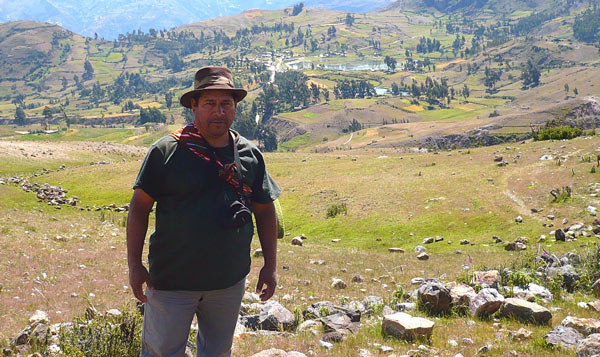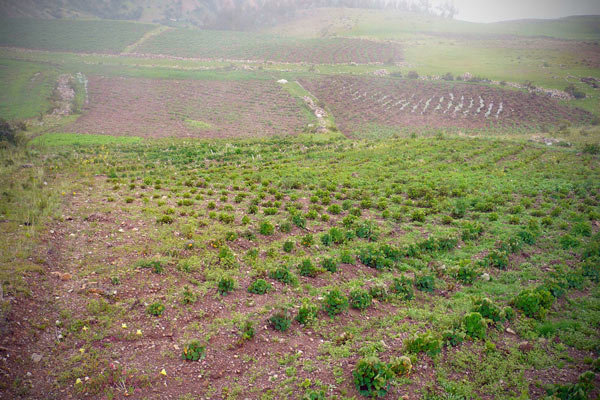Sophisticated traditional potato practices still exist today, despite the advance of modern farming techniques, and around the world they are continually being adapted to changing environments. By conserving and adapting these traditions and farming dynamics, farmers may increase varietal selections, reduce the use of harmful fertilizers and pesticides, and produce healthier potato crops.
Traditional farmers have cultivated potato for more than 8000 years in the Andean highlands. Over these years, different cultures have bred new varieties and developed innovative practices to protect against crop failure and hunger. The introduction of fertilizers and pesticides to rural communities in the 20th century helped to protect against famine, but also led to a dependency on new technologies and a reduction in potato varieties. Traditional practices and dynamics still exist and are adapted to changing environments, and if farmers conserve and use them, they could increase varietal selections, reduce the use of harmful fertilizers and pesticides, and produce healthier potato crops.
Juan Palomino works as a maintenance technician at the International Potato Center (CIP). With an unpretentious and down to earth attitude, he is also very eager to share knowledge and knowhow about potato farming and traditions from and the Andes and show how they are still very important and applicable today.
“Our ancestors have been using different practices to grow potatoes in harmony with the natural world for thousands of years,” says Palomino, “and while many farmers are forgetting these practices, it is important for the environment and our own wellbeing that these are continued.”

CIP’s Juan Palomino farms potato outside of his hometown of Titimina in Ayacucho
Palomino comes from a small town called Titimina a few hours northeast of Ayacucho, and it is here that he farms potatoes and other crops in small land parcels called chakras.
The layout of the chakra makes excellent use of mountain land, and gives the potato crops the best chance for survival among the other crops grown within the same area. Primarily, Palomino plants crops such as quinoa, oats, and barley in rectangular stretches called takeras that measure one meter by 15 meters and descend horizontally down the slope of the chakra. Crops are interspersed between takeras (approximately 10 per chakra), so quinoa grows alongside green beans, the next barley, the next oats, the next quinoa, and the pattern repeats. Palomino grows potatoes in narrow crop lanes that zigzag and intersect through the takeras in perpendicular lanes running down the slope.
While the potato has a high uptake of soil nutrients, causes soil erosion, and over production can lead to severe soil depletion, the other crops are not particularly demanding on the soil. Planting the potato amongst these takeras therefore lowers the demands on the land.

Palomino plants his crops in rectangular stretches called takeras, which cascade down the gradient of each chakra.
While CIP is currently carrying out research into increasing water efficiency techniques for potato production, Palomino explains how traditional zigzagging potato lanes increase water efficiency and lower the impacts of soil erosion. Each zigzagging lane has a width of a meter, with each grown a meter and a half apart. With about 15 zigzagged crop lanes in each chakra, a lot of space is dedicated to the potato. Water flows down the lanes to irrigate the crops while the zigzag embankments hold the soil firmly in place. “This makes irrigation easier, and also ensures that water runoff does not erode the topsoil,” Says Palomino.

Palomino plants potatoes in zigzagged lines that intercut through the takeras.
According to CIP’s Genetic Resources Global Science Leader, Stef de Haan, “The practice of zigzag potato crop lines is an ancient and traditional potato farming practice employed to effectively avoid soil erosion on steep growing areas.” This is a practice used in combination with other traditional practices that are still widely used throughout the Andes such as the footplow-based minimal tillage systems called chiwa and chacmeo, field scattering, sectoral fallowing, and within-field varietal mixtures (chaqru). According to de Haan, these practices, “Contribute to yield stability, resource conservation, and mitigation risk.”
In order to protect against crop failure, Palomino says that he plants mashua around each chakra to protect plants from pests. Mashua is an excellent natural insecticide that rural farmers use to protect crops across Peru. However, he admits that the biggest threats to his crops are adverse weather conditions.
“Protecting against water shortages is something many people have forgotten,” says Juan Palomino. “If crops fail because of a drought, farmers can turn to the government for assistance and eat cheap packaged foods. This was not always the case.” Palomino describes how his father taught him to protect against water shortages by planting a variety of drought tolerant plants such as the Arbol de Molle (Peruvian pepper tree), Planta de Sankay (Sankay cactus), Flor de Retama (Retama flower), Flor de Mutuy (Mutuy flower), and Flor de Yuyo (Yuyo flower). These plants require very little water and farmers can process them for food if other crops fail.
However, the greatest way to protect against hunger is to adequately store crops that farmers can consume during times of hardship. While CIP consistently seeks to provide improved cold storage practices and technology for the world’s potato farmers, the reality is that many poor farmers still do not have the adequate knowledge or resources to store potato crops for lengthy periods of time.
Juan Palomino describes a traditional practice for storing potatoes other than the well-known freeze drying method. In order to store his potatoes, he interlayers them with muña (Minthostachys mollis) and buries them in holes in the ground. “Muña has a strong scent that insects and bacteria avoid and the earth helps to keep the potatoes cool and fresh,” says Palomino. The potatoes can last for up to seven months (more than the complete growing cycle of a potato crop).
By using and integrating traditional practices in rural potato production, farmers such as Palomino are playing an important role in helping to produce healthier crops on less land. Furthermore, these farmers are working towards mitigating the effects of severe weather conditions by employing practices that may help them survive crop failures. “It’s about using our traditions to prepare for the future,” claims Palomino, “And I would like to see more farmers adopting these techniques in case tough times lie ahead.”
